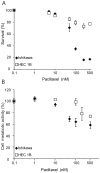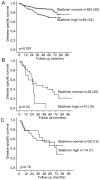Stathmin protein level, a potential predictive marker for taxane treatment response in endometrial cancer
- PMID: 24587245
- PMCID: PMC3934991
- DOI: 10.1371/journal.pone.0090141
Stathmin protein level, a potential predictive marker for taxane treatment response in endometrial cancer
Abstract
Stathmin is a prognostic marker in many cancers, including endometrial cancer. Preclinical studies, predominantly in breast cancer, have suggested that stathmin may additionally be a predictive marker for response to paclitaxel. We first evaluated the response to paclitaxel in endometrial cancer cell lines before and after stathmin knock-down. Subsequently we investigated the clinical response to paclitaxel containing chemotherapy in metastatic endometrial cancer in relation to stathmin protein level in tumors. Stathmin level was also determined in metastatic lesions, analyzing changes in biomarker status on disease progression. Knock-down of stathmin improved sensitivity to paclitaxel in endometrial carcinoma cell lines with both naturally higher and lower sensitivity to paclitaxel. In clinical samples, high stathmin level was demonstrated to be associated with poor response to paclitaxel containing chemotherapy and to reduced disease specific survival only in patients treated with such combination. Stathmin level increased significantly from primary to metastatic lesions. This study suggests, supported by both preclinical and clinical data, that stathmin could be a predictive biomarker for response to paclitaxel treatment in endometrial cancer. Re-assessment of stathmin level in metastatic lesions prior to treatment start may be relevant. Also, validation in a randomized clinical trial will be important.
Conflict of interest statement
Figures





Similar articles
-
Predictive value of microtubule associated proteins tau and stathmin in patients with nonmuscle invasive bladder cancer receiving adjuvant intravesical taxane therapy.J Urol. 2011 Nov;186(5):2094-100. doi: 10.1016/j.juro.2011.06.051. Epub 2011 Sep 23. J Urol. 2011. PMID: 21944130
-
High stathmin expression is a marker for poor clinical outcome in endometrial cancer: An NRG oncology group/gynecologic oncology group study.Gynecol Oncol. 2017 Aug;146(2):247-253. doi: 10.1016/j.ygyno.2017.05.017. Epub 2017 May 19. Gynecol Oncol. 2017. PMID: 28532857 Free PMC article.
-
High phospho-Stathmin(Serine38) expression identifies aggressive endometrial cancer and suggests an association with PI3K inhibition.Clin Cancer Res. 2013 May 1;19(9):2331-41. doi: 10.1158/1078-0432.CCR-12-3413. Epub 2013 Mar 28. Clin Cancer Res. 2013. PMID: 23538402
-
Emerging role of taxanes in adjuvant and neoadjuvant therapy for breast cancer: the potential and the questions.Surg Clin North Am. 2003 Aug;83(4):943-71. doi: 10.1016/S0039-6109(03)00071-9. Surg Clin North Am. 2003. PMID: 12875604 Review.
-
Taxane resistance in breast cancer: mechanisms, predictive biomarkers and circumvention strategies.Cancer Treat Rev. 2012 Nov;38(7):890-903. doi: 10.1016/j.ctrv.2012.02.011. Epub 2012 Mar 31. Cancer Treat Rev. 2012. PMID: 22465195 Review.
Cited by
-
STMN1 and MKI67 Are Upregulated in Uterine Leiomyosarcoma and Are Potential Biomarkers for its Diagnosis.Med Sci Monit. 2020 May 19;26:e923749. doi: 10.12659/MSM.923749. Med Sci Monit. 2020. PMID: 32425177 Free PMC article.
-
High STMN1 level is associated with chemo-resistance and poor prognosis in gastric cancer patients.Br J Cancer. 2017 Apr 25;116(9):1177-1185. doi: 10.1038/bjc.2017.76. Epub 2017 Mar 23. Br J Cancer. 2017. PMID: 28334732 Free PMC article.
-
LIM1 contributes to the malignant potential of endometrial cancer.Front Oncol. 2023 Mar 10;13:1082441. doi: 10.3389/fonc.2023.1082441. eCollection 2023. Front Oncol. 2023. PMID: 36969081 Free PMC article.
-
Overexpression of stathmin plays a pivotal role in the metastasis of esophageal squamous cell carcinoma.Oncotarget. 2017 Jun 27;8(37):61742-61760. doi: 10.18632/oncotarget.18687. eCollection 2017 Sep 22. Oncotarget. 2017. PMID: 28977901 Free PMC article.
-
Evaluation of endometrial carcinoma prognostic immunohistochemistry markers in the context of molecular classification.J Pathol Clin Res. 2017 Oct 14;3(4):279-293. doi: 10.1002/cjp2.82. eCollection 2017 Oct. J Pathol Clin Res. 2017. PMID: 29085668 Free PMC article.
References
-
- Belletti B, Baldassarre G (2011) Stathmin: a protein with many tasks. New biomarker and potential target in cancer. Expert opinion on therapeutic targets 15: 1249–1266. - PubMed
-
- Rubin CI, Atweh GF (2004) The role of stathmin in the regulation of the cell cycle. Journal of cellular biochemistry 93: 242–250. - PubMed
-
- Biomarkers Definitions Working G (2001) Biomarkers and surrogate endpoints: preferred definitions and conceptual framework. Clinical pharmacology and therapeutics 69: 89–95. - PubMed
Publication types
MeSH terms
Substances
LinkOut - more resources
Full Text Sources
Other Literature Sources

